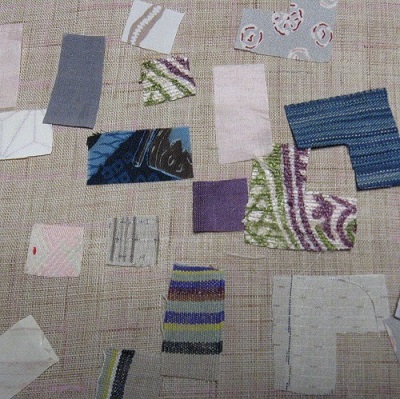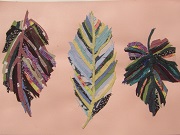About Artist
About Artist

Megumi Kaneko
I learned weaving and dyeing in Tamagawa University in Tokyo for 4 years, I tried to be a weaver after the graduation.
I think now, I got an opportunity to become an artist then it bring another opportunity, and it bring another chance to start something new.
There were 3 keys I have got to change my life to become an artist.
No1 is having feeling of awe of natural beauty.
No2 is discovering a small existence those have a weak presence.
No3 is having appreciation to ancient people’s wisdom.
No1
The first key is I have feeling of awe of natural beauty.
I was born in Tokyo, but in my teenage, I grew up in a mountainside in Nagano prefecture.
It is a region center of Japan, there are many mountains and rivers.
My house was next to a ski slope.
My father loved to live in such a natural place.
I had to walk 1 hour to go to school, and in winter I put ski board all the way.
While living in the natural place, I watched at the colors of 4 seasons beautiful leaves, sky, mountain slope, surface of rocks, brightness of the snow, up close, and distant.
I was moved by colors existing in nature a lot while living in the mountain side.
When I enter the university, I learned about fabric and yarns, I died yarns by myself.
And I wove many tapestries.
I had joy to mix artificial color with natural one.
And, I got large cloth and yarns scraps after production of my works.
I couldn’t through away because I loved the texture and colors of them.
I became thinking only about them since some time, I couldn’t get them off my mind.
No2 key is discovering a small existence those have a weak presence.
I became feeling that producing my work from new yarns and from scraps are the same.
Because I got a chance a volunteer to lead old age ladies in a nursing home to create pictures with many pieces of old Japanese kimono fabrics.
The old ladies around 80, 90 are wonderful, very creative, they made me fun.


I feel that the volunteer work made me open my mind it is like opening window to get fresh air.
I feel so free to use the useless fabrics.
Now, I feel so much fun to create with the scraps than weaving.
You know, weaving need precise measurements and draw plans.
Recently, I think my art work is between pure-art and crafts.
Old Japanese people used to use old Kimono to make new one.
They were so great to recycle.
They used cloth in many ways.
I heard that in the old day,
Buddhist monks made their surplice of left over cloth, scraps.

No3
The third point, I am having appreciation to ancient people’s wisdom.
I thought of Ancient people.
I imagined that they would keep going to create a sign to show important information for others and descendants in a map.
It would be a point that lots of gold coins or treasure were buried in.
I loved seeing Ancient people’s weaving, Native American Indian’s rug about 100 years old, Indonesian, Thailand’s Ikat, those were in a small village in deep mountain side.
I loved traveling to see them and learned how they made those works and structures, also colors with natural dying and they faded out of the fabric beautifully.
Then I tried to find something background of their lives.
I read many books of American Indians, Inuit, many tribes in Thailand, Indonesia, and Japanese island.
Knowing about their lives was one of my enthusiasm.
I imagined the idea of spending time for Ancient people is so different from people like us.
It must be the difference, maybe, ways to survive, or to celebrate lives, and to express love for family members, communities, their ancestors, and descendants, how to appreciate their gods, so on.
For example, 1 hour for us is not the same for them.
Or, I can say that in order to complete one rug, they spend tranquil time.
They had no idea to waste time and no conception of punctuality.
I think they may offer the best thing to their gods because a belief in supernatural powers and they got power to create something special.
So, they had handed down not only their skills or technic but their mind to give attention to devote their lives to gods or Buddha, or some an object of veneration.
That is why they created fabrics and daily goods, having small and delicate designs and very fine textures.
So, I learned a lot through traveling and now I respect them and try to follow their ways and wisdom.
And in my career, I started a job about 30 years ago, as a food stylist of TV show, magazines, and advertising for my living by introduction of various people, and they helped me to have joy art indirectly.
Those experiences brought me Urushi, which is lacquer called Japan.
It is sap of Japanese sumac tree that is natural glue, glue the fragments of a plate back together.
It is called Kintsugi. In Japan, people used Urushi for long time.
In Japan, walls of temples, shrines are painted by Urushi.
Many pieces painted by Urushi have been discovered in the old remains of Jomon period about 6,000 years ago.
In my job, I used many kinds of wooden and ceramic ware, and also got many broken dishes, bowls too.
In the beginning time of my career, I had to give up those, but my husband had many old wood broken bowls they were handed down from his grandmother, I didn’t want to give up those because they are part of old culture.
I decided to study how to repair those with Urushi and all natural materials which is traditional Japanese technic.
Sometimes my skin got rush and itchy from it. Now I am OK.
Since I started it I have been repaired many broken table wares
I started to use Urushi for my art pieces, too.
It takes time to go to next step in the process using Urushi.
After put Urushi and make it dry with moderate temperature and humidity.
It is about 25 degrees and 80%.
When it gets dry, I rub down the surface with sand paper or charcoal and put Urushi.
I do the same work process repeatedly.
Time moves very slowly in my studio as well as in Jomon period.

Now I feel that something invisible power have pushed me going forward to meet various people, materials like Urushi, Japanese natural glue, Washi, Japanese handmade paper, and fabric, yarn useless waste.
And I think my ancestors they were Japanese, or maybe came from China or Korea followed Buddhism and Shintoism.
Masters of those have been teaching us that everything has Buddha nature or heart even a pebble on a path or bubble in water.
So, I would like to follow the wisdom of tradition, take care of things even small.
And I would like to open a window to get fresh air in a traditional room.
I want to step forward with amount of cloth waste.
About the composition of my work.
My teacher is Ancient people.
I would like to build tone with lines and colors of fabrics and yarns.
And try to lead eyes circulate through space in the picture, having harmony with colors.
Decentralize and centralize.
.
And,
I was inspired by Stewart Wilson of the Personaland.
He created Persona over 30,000 with scrap fabrics.
Also Robert Kobayashi, he is famous as tin art.
Sol LeWitt and Paul Klee.
My Buddhist master said that “don’t make light of grain of rice and a drop of water, have consideration and appreciation for the earth.
Because the resources of the earth will help us.”
And my grandmother also said same thing.
Namu Shinnyo
★Namu means to become one, and
Shinnyo means absolute truth, ultimate reality, true nature of all things, and unseen Buddha nature.